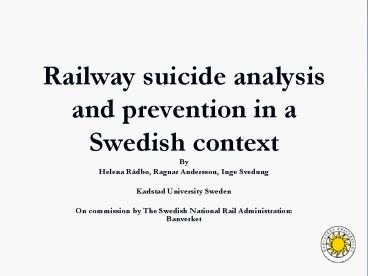Railway suicide analysis and prevention in a Swedish context PowerPoint PPT Presentation
1 / 22
Title: Railway suicide analysis and prevention in a Swedish context
1
Railway suicide analysis and prevention in a
Swedish context
- By
- Helena Rådbo, Ragnar Andersson, Inge Svedung
- Karlstad University Sweden
- On commission by The Swedish National Rail
Administration Banverket
2
List of studies
- Suicide and other fatalities from train-person
collision on Swedish railroads A descriptive
epidemiologic analysis as basis for
systems-oriented prevention - Suicide Prevention in Railway Systems
Application of a barrier approach - Suicide and potentials for suicide prevention on
the Swedish Rail Network a qualitative multiple
case study - Feasibility of railway suicide prevention
strategies a focus group study
3
Background
- A major public health problem
- More and 75 of all fatal train person
collisions are suicides - The dominating cause of fatal injuries in the
Swedish railway system
4
Aim of study 1
To give an epidemiologic description of the
railway suicide problem in Sweden To compare
similarities and differences between suicidal
and accidental train person collisions
5
Materials and methods
- Reports on fatal incidents available at the
Swedish National Railway Administration - Includes all fatal railway incidents in three
years 2000-2002
6
Sex of victim
7
Age
8
Daytime vs. night time
9
Urban vs. rural areas
10
Activity and movement pattern
11
Conclusion
- Victims normally trespass track area a good while
before train arrives - Incidents are highly concentrated to densely
populated areas - Suicidal and accidental incidents show many
similarities (from a preventive point of view)
12
Aim and Method study 2
To theoretically derive and categorise a set of
railway suicide prevention strategies
Methodologically, generic accident and suicide
prevention models were synthesized
13
Suicidal process model
Decision to enter tracks
Lethal outcome
Suicidal thought
Collision
System based preventive measures
Prevention related to presumptive victims
Modified from Beskow (1979)
14
Fall tree analysis Two basic conditions for
critical impact
Critical impact
and
Person on the tracks
Train with critical impact potential
and/or
and/or
15
Energy model
TRAIN (Energy source)
VICTIM (vulnerable target)
BARRIERS
After William Haddon
16
A combined list with barriers from both FTA and
Haddons 10 strategies
- Abolish rail transportation
- Reduce frequency and mass (regarding speed, se
below) - Increase individual and public knowledge on
existing barrier functions, survival rate, etc. - (if not considered counter-productive)
- Reduce spatial and temporal availability
- Physical barriers fences, bars, etc.
- Spatial barriers tunnels, elevated tracks
- Electronic barriers detection and alarm
functions - Human barriers professional or public
surveillance
- Repulsive functions
- Removal functions Speed limits
- Braking capacity
- Driver alerting (visibility, signals, etc.)
- Rail and surrounding structure design
- Front design
- Deflecting devices
- Wheel design
- Stabilize, cure and rehabilitate
- First aid
- Health care
- Rehabilitation (physical and mental)
17
Aim and Method study 3
- To evaluate existing police and rail
administration reports on railway suicide
incidents - To identify and categorize additional
preventive-oriented information - Method Multiple Case-study
18
Results
- Police and Railway administration usually collect
adequate background information on train, place
and victim - Missing details of relevance for the prevention
- Victims behaviour before collision
- Circumstances preceding the collision
- Characteristics of the location
19
Aim and Method study 4
- To analyse the acceptance of proposed
preventative strategies among relevant
professional groups - To validate and further develop these strategies
- Focus Group interviews
20
Model of measures
21
Result
Result
- General acceptance and understanding
- All principles were considered relevant
- Some more realistic than others for practical
implementation
22
Thank you for your attention
- Helena.radbo_at_kau.se

